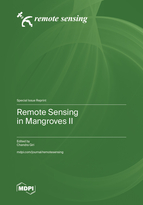Remote Sensing in Mangroves II
A special issue of Remote Sensing (ISSN 2072-4292). This special issue belongs to the section "Forest Remote Sensing".
Deadline for manuscript submissions: closed (31 October 2022) | Viewed by 62434
Special Issue Editor
Interests: mangrove forests mapping and monitoring using high-resolution satellite data; global and continental land cover mapping and monitoring using multi-spectral, multi-temporal, and multi-platform remotely sensed data; image pre-processing, classification, and validation using cloud computing
Special Issues, Collections and Topics in MDPI journals
Special Issue Information
Dear Colleagues,
Mangrove forests are in constant flux due to both natural and anthropogenic forces. The changing mangroves will have important consequences to coastal communities. At present, conversion of mangroves to other land uses is the dominant factor responsible for the change; however, sea level rise and natural disaster such as hurricane are becoming increasingly dominant. Observation and monitoring of the distribution and dynamics of mangroves is central to a wide range of scientific investigations conducted in both terrestrial and marine ecosystems.
Recent advancements in remote sensing data availability, image-processing methodologies, computing and information technology, and human resources development have provided an opportunity to observe and monitor mangroves from local to global scales on a regular basis. The spectral, spatial, and temporal resolution of remote sensing data and their availability have improved, making it possible to observe and monitor mangroves with unprecedented spatial thematic and temporal details. Novel remote sensing platforms such as unmanned aerial vehicles, and emerging sensors such as Fourier transform infrared spectroscopy and Lidar can now be used for mangrove monitoring. Furthermore, it is now possible to store and analyze large volumes of data using cloud computing.
The journal Remote Sensing announces a Special Issue dedicated to the observation and monitoring of mangroves using remote sensing from local to global scales. The Issue will broadly cover the application of remote sensing using optical (multi-spectral and hyperspectral), radar, and Lidar data obtained from multiple platforms including ground, air, and space. Research papers are expected to use the latest techniques to acquire, manage, exploit, process, and analyze a wide variety of remote sensing data for mangrove forest applications. Both research papers and innovative review papers are invited.
High-quality contributions emphasizing (but not limited to) the topic areas listed below are solicited for the Special Issue:
- Application of aerial and ground remote sensing, photography, multi-spectral, multi-temporal and multi-resolution, satellite data, synthetic aperture radar (SAR) data, hyperspectral data, and Lidar data.
- Application of advanced image pre-processing for geometric, radiometric, and atmospheric correction, cloud removal, and image mosaicking.
- Application of advanced image classification and validation techniques including supervised and unsupervised classification.
- Application of advanced image storage, retrieval, processing, and distribution techniques such as networked data transmission and distributed computing.
- Application of remote sensing to derive spatio-temporal information on mangrove forests distribution, species discrimination, forest density, forest health, mangrove expansion and contraction, and other ongoing changes in mangrove ecosystems.
Dr. Chandra Giri
Guest Editor
Manuscript Submission Information
Manuscripts should be submitted online at www.mdpi.com by registering and logging in to this website. Once you are registered, click here to go to the submission form. Manuscripts can be submitted until the deadline. All submissions that pass pre-check are peer-reviewed. Accepted papers will be published continuously in the journal (as soon as accepted) and will be listed together on the special issue website. Research articles, review articles as well as short communications are invited. For planned papers, a title and short abstract (about 100 words) can be sent to the Editorial Office for announcement on this website.
Submitted manuscripts should not have been published previously, nor be under consideration for publication elsewhere (except conference proceedings papers). All manuscripts are thoroughly refereed through a single-blind peer-review process. A guide for authors and other relevant information for submission of manuscripts is available on the Instructions for Authors page. Remote Sensing is an international peer-reviewed open access semimonthly journal published by MDPI.
Please visit the Instructions for Authors page before submitting a manuscript. The Article Processing Charge (APC) for publication in this open access journal is 2700 CHF (Swiss Francs). Submitted papers should be well formatted and use good English. Authors may use MDPI's English editing service prior to publication or during author revisions.
Keywords
- Mangrove forests
- Mangrove change
- Mapping
- Monitoring
- Remote sensing
- Image processing
Related Special Issues
- Remote Sensing in Mangroves in Remote Sensing (13 articles)
- Remote Sensing in Mangroves III in Remote Sensing (7 articles)






